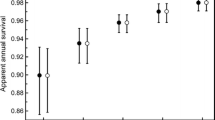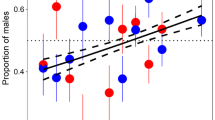Summary
We analysed 6 years of reproduction data for 176 California gulls (Larus californicus) surviving from 1980 to 1988. Using a statistical model adapted from Rao's (1958) and Tucker's (1966) generalized growth curve analysis, we reconstructed the reproductive patterns of gulls aged from 0 to 26 years. Individuals were highly consistent in following one of two patterns of reproduction. In a primary pattern employed by most gulls, individuals skipped breeding less frequently and laid larger clutches as they aged. Clutch size increased to a plateau and remained at high levels throughout remaining life. In an alternate pattern employed by a smaller subset of the sample, clutch size also increased to a plateau. However, as a result of frequent skipping of breeding and smaller clutches, this plateau was considerably lower compared to that of gulls adopting the primary reproductive pattern. Data on fledging success from 1980 and 1984 were consistent with the finding of two reproductive patterns. Gulls adopting the alternate reproductive pattern produce fewer offspring per breeding attempt but survive longer than gulls adopting the primary pattern. The frequency of gulls employing the alternate pattern will increase with age relative to gulls employing the primary pattern. The alternate pattern, and not senescence, may explain why several cross-sectional studies on seabirds report declines among the oldest breeders in measures of clutch size, egg mass, hatching success, and fledging success.
Similar content being viewed by others
References
Behle, W. H. (1958)The Bird Life of the Great Salt Lake. University of Utah Press, Salt Lake City, Utah, USA.
Brooke, M. de L. (1978) Some factors affecting the laying date, incubation and breeding success of the Manx ShearwaterPuffinus puffinus.J. Anim. Ecol. 47, 477–95.
Burger, J., Olla, B. L. and Winn, H. E. (eds) (1980)Behavior of Marine Animals. Volume 4. Plenum Press, New York, USA.
Cattell, R. B. (1966) The scree test for the number of factors.Multivar. Behav. Res. 1, 245–76.
Charlesworth, B. (1980)Evolution in Age-structured Populations. Cambridge University Press, New York, USA.
Coulson, J. C. and Thomas, C. S. (1985) Differences in the breeding performance of individual Kittiwake Gulls,Rissa tridactyla (L.) Behavioral Ecology: Ecological Consequences of Adaptive Behavior. (R. M. Sibley and R. H. Smith, eds), pp. 489–503. Blackwell Scientific Publications, Oxford, UK.
Coulson, J. C. and Horobin, J. (1976) The influence of age on the breeding biology and survival of the Arctic Tern (Sterna paradisaea).J. Zool. 178, 247–60.
Coulson, J. C. and Wooller, R. D. (1976) Differential survival rates among breeding Kittiwake GullsRissa tridactyla (L.).J. Anim. Ecol. 45, 205–13.
Davis, J. W. F. (1975) Age, egg-size and breeding success in the Herring GullLarus argentatus.Ibis 117, 460–73.
Dawkins, R. (1980) Good strategy or evolutionary stable strategy?Sociobiology: Beyond Nature/Nurture. (G. W. Barlow and J. Silverberg, eds.), pp. 331–67. AAAS Selected Symposium No. 35. Westview Press, Boulder, Colorado, USA.
Gross, M. R. (1982) Sneakers, satellites, and parentals: polymorphic mating strategies in North American sunfishes.Z. Tierpsychologie 60, 1–26.
Gross, M. R. (1985) Disruptive selection for alternative life histories in salmon.Nature 313, 47–8.
Harman, H. H. (1973)Modern Factor Analysis. (3rd Ed.) University of Chicago Press, Chicago, Illinois, USA.
Haymes, G. T. and Blokpoel, H. (1980) The influence of age on the breeding biology of Ring-billed Gulls.Wilson Bull. 92, 221–8.
Howard, R. D. (1984) Alternative mating behaviors of young male bullfrogs.American Zoology 24, 397–406.
Kennedy, J. R. (1973) A Study of the Breeding Colony of California Gulls (Larus californicus), Bamforth Lake, Albany County, Wyoming. Thesis. University of Wyoming, Laramie, Wyoming, USA.
Krebs, J. R. and Davies, N. B. (1981)An Introduction to Behavioural Ecology. Sinauer, Sunderland, Mass., USA.
Maynard Smith, J. (1982)Evolution and the Theory of Games. Cambridge University Press, Cambridge, UK.
Mills, J. A. and Shaw, P. W. (1980) The influence of age on laying date, clutch size, and egg size of the White-fronted Tern,Sterna striata.New Zeal. J. Zool. 7, 147–53.
Nelson, J. B. (1966) Breeding Biology of the GannetSula bassanus on the Bass Rock, Scotland.Ibis 108, 524–6.
Nisbet, I. C., Winchell, J. M. and Heise, A. E. (1984) Influence of age on the breeding biology of Common Terns.Colonial Waterbirds 7, 117–26.
Ollason, J. C. and Dunnett, G. M. (1988) Variation in breeding success in Fulmars.Reproductive Success: Studies of Individual Variation in Contrasting Breeding Systems. (T. H. Clutton-Brock, ed.), pp. 263–78. University of Chicago Press, Chicago, Illinois, USA.
Pugesek, B. H. (1981) Increased reproductive effort with age in the California Gull (Larus californicus).Science 212, 822–3.
Pugesek, B. H. (1983) The relationship between parental age and reproductive effort in the California Gull (Larus californicus)Behav. Ecol. and Sociobiol.,13, 161–71.
Pugesek, B. H. (1987) Age-specific survivorship in relation to clutch size and fledging success in California Gulls.Behav. Ecol. and Sociobiol. 21, 217–21.
Pugesek, B. H. and Diem, K. L. (1983) A multivariate study of the relationship of parental age to reproductive success in California Gulls.Ecology 64, 829–39.
Pugesek, B. H. and Diem, K. L. (1990) The relationship between reproduction and survival in known-aged California Gulls.Ecology 71, 811–17.
Rao, C. R. (1958) Some statistical methods for the comparison of growth curves.Biometrics 14, 1–17.
Richdale, L. E. (1957)A Population Study of Penguins. Clarendon Press, Oxford, UK.
Rubenstein, D. I. (1980) On the evolution of alternative mating strategies.Limits to Action: The Allocation of Individual Behavior. (J. E. R. Staddon, ed.), pp. 65–100. Academic Press, New York, USA.
Spurr, E. B. (1975) Breeding of the Adelie PenguinPygoscalis adeliae at Cape Bird.Ibis 117, 324–38.
Thomas, C. S. (1983) The relationship between breeding experience, egg volume, and reproductive success of the KittiwakeRissa tridactyla.Ibis 125, 567–74.
Thomas, C. S. and Coulson, J. C. (1988) Reproductive success of Kittiwake Gulls,Rissa tridactyla.Reproductive Success: Studies of Individual Variation in Contrasting Breeding Systems. (T. H. Clutton-Brock, ed.), pp. 251–62. University of Chicago Press, Chicago, Illinois, USA.
Tucker, L. R. (1966) Learning theory and multivariate experiment: illustration of determination of generalized learning curves.Handbook of Multivariate Experimental Psychology. (R. B. Cattell, ed.), pp. 476–501. Rand McNally, New York, USA.
Van Den Berghe, E. P. and Gross, J. R. (1989) Natural selection resulting from female breeding competition in a Pacific salmon (coho:Oncorhynchus kistuch).Evolution 43(1), 125–40.
Van Rhijn, J. G. (1973) Behavioural dimorphism in male ruffs,Philomachus pugnax (L.).Behaviour 47, 10–229.
Wood, P. K. (1992) Generation and objective rotation of generalized learning curves using matrix language products.Multivar. Behav. Res. (In press).
Wooller, R. D. and Coulson, J. C. (1977) Factors affecting the age of first breeding of the KittiwakeRissa tridactyla.Ibis 119, 339–49.
Author information
Authors and Affiliations
Rights and permissions
About this article
Cite this article
Pugesek, B.H., Wood, P. Alternate reproductive strategies in the California gull. Evol Ecol 6, 279–295 (1992). https://doi.org/10.1007/BF02270965
Issue Date:
DOI: https://doi.org/10.1007/BF02270965




